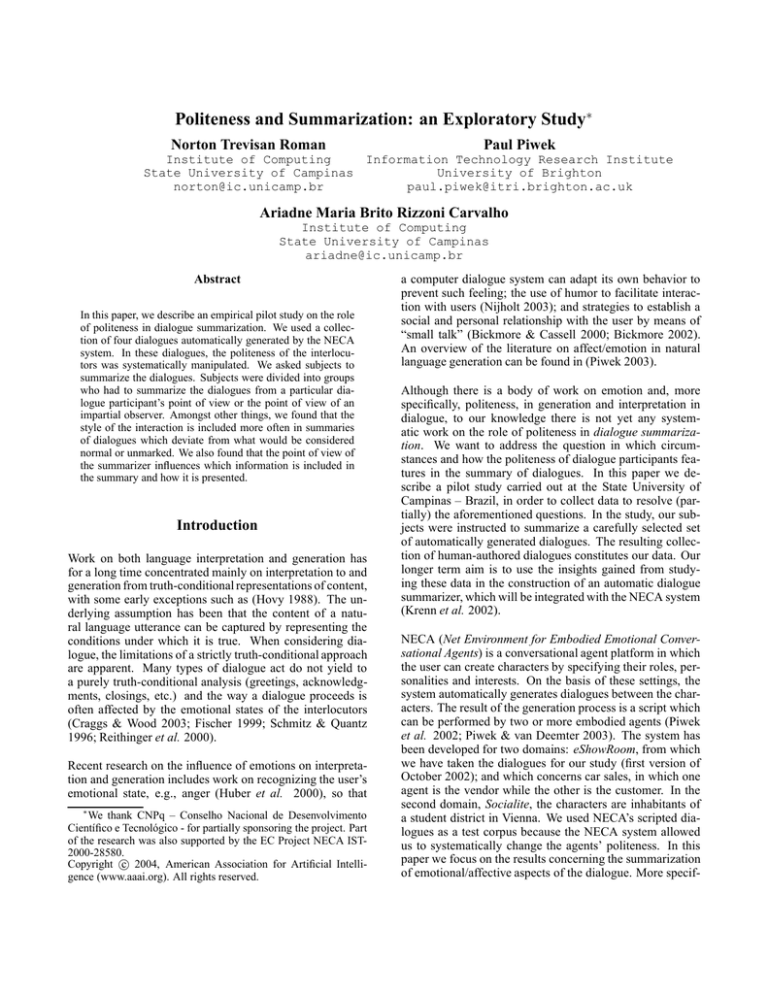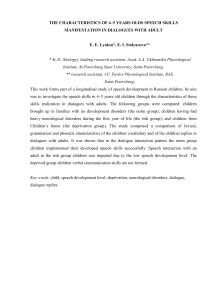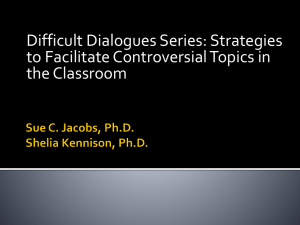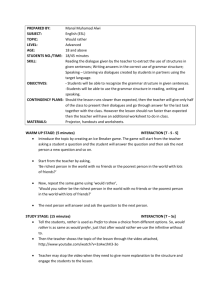
Politeness and Summarization: an Exploratory Study∗
Norton Trevisan Roman
Paul Piwek
Information Technology Research Institute
Institute of Computing
University of Brighton
State University of Campinas
paul.piwek@itri.brighton.ac.uk
norton@ic.unicamp.br
Ariadne Maria Brito Rizzoni Carvalho
Institute of Computing
State University of Campinas
ariadne@ic.unicamp.br
Abstract
In this paper, we describe an empirical pilot study on the role
of politeness in dialogue summarization. We used a collection of four dialogues automatically generated by the NECA
system. In these dialogues, the politeness of the interlocutors was systematically manipulated. We asked subjects to
summarize the dialogues. Subjects were divided into groups
who had to summarize the dialogues from a particular dialogue participant’s point of view or the point of view of an
impartial observer. Amongst other things, we found that the
style of the interaction is included more often in summaries
of dialogues which deviate from what would be considered
normal or unmarked. We also found that the point of view of
the summarizer influences which information is included in
the summary and how it is presented.
Introduction
Work on both language interpretation and generation has
for a long time concentrated mainly on interpretation to and
generation from truth-conditional representations of content,
with some early exceptions such as (Hovy 1988). The underlying assumption has been that the content of a natural language utterance can be captured by representing the
conditions under which it is true. When considering dialogue, the limitations of a strictly truth-conditional approach
are apparent. Many types of dialogue act do not yield to
a purely truth-conditional analysis (greetings, acknowledgments, closings, etc.) and the way a dialogue proceeds is
often affected by the emotional states of the interlocutors
(Craggs & Wood 2003; Fischer 1999; Schmitz & Quantz
1996; Reithinger et al. 2000).
Recent research on the influence of emotions on interpretation and generation includes work on recognizing the user’s
emotional state, e.g., anger (Huber et al. 2000), so that
∗
We thank CNPq – Conselho Nacional de Desenvolvimento
Cientı́fico e Tecnológico - for partially sponsoring the project. Part
of the research was also supported by the EC Project NECA IST2000-28580.
c 2004, American Association for Artificial IntelliCopyright gence (www.aaai.org). All rights reserved.
a computer dialogue system can adapt its own behavior to
prevent such feeling; the use of humor to facilitate interaction with users (Nijholt 2003); and strategies to establish a
social and personal relationship with the user by means of
“small talk” (Bickmore & Cassell 2000; Bickmore 2002).
An overview of the literature on affect/emotion in natural
language generation can be found in (Piwek 2003).
Although there is a body of work on emotion and, more
specifically, politeness, in generation and interpretation in
dialogue, to our knowledge there is not yet any systematic work on the role of politeness in dialogue summarization. We want to address the question in which circumstances and how the politeness of dialogue participants features in the summary of dialogues. In this paper we describe a pilot study carried out at the State University of
Campinas – Brazil, in order to collect data to resolve (partially) the aforementioned questions. In the study, our subjects were instructed to summarize a carefully selected set
of automatically generated dialogues. The resulting collection of human-authored dialogues constitutes our data. Our
longer term aim is to use the insights gained from studying these data in the construction of an automatic dialogue
summarizer, which will be integrated with the NECA system
(Krenn et al. 2002).
NECA (Net Environment for Embodied Emotional Conversational Agents) is a conversational agent platform in which
the user can create characters by specifying their roles, personalities and interests. On the basis of these settings, the
system automatically generates dialogues between the characters. The result of the generation process is a script which
can be performed by two or more embodied agents (Piwek
et al. 2002; Piwek & van Deemter 2003). The system has
been developed for two domains: eShowRoom, from which
we have taken the dialogues for our study (first version of
October 2002); and which concerns car sales, in which one
agent is the vendor while the other is the customer. In the
second domain, Socialite, the characters are inhabitants of
a student district in Vienna. We used NECA’s scripted dialogues as a test corpus because the NECA system allowed
us to systematically change the agents’ politeness. In this
paper we focus on the results concerning the summarization
of emotional/affective aspects of the dialogue. More specif-
ically, we investigate how the politeness of both dialogue
partners can influence human-authored summaries.
Experimental setup
Our pilot study was carried out over a period of two months
– July and August, 2003 – at the State University of Campinas, Brazil, with thirty subjects and four dialogues. The
thirty subjects were: 1 graduate, 8 MSc students, 20 PhD
students and 1 PhD, mostly male. Table 1 shows the number
of subjects according to their educational degree, sex and
course.
Degree
Graduated
MSc Student
PhD Student
PhD
1
8
20
1
Sex
Masc. 18
Fem.
12
Course
Physics
Biology
Civil Eng.
Computer Sci.
1
1
1
27
the politeness of the interlocutors. This was achieved by instructing the system to hold interests and other personality
traits constant, but vary politeness. The scripted dialogues
generated by the NECA system are, of course, only an approximation of naturally occurring dialogues. This need not
be a deficiency, many dialogues that we see and hear every
day are not naturally occurring dialogues (dialogues in film,
soaps, etc. on radio, TV, etc.).
All subjects were told to summarize the dialogues as if they
had been present during the dialogue and were telling a
friend what happened. In particular, this included 10 subjects who were told to summarize the dialogue from the
point of view of the customer, a further 10 who were told
to summarize the dialogues as if they were the vendor and,
finally, 10 who were told to summarize the dialogues as if
they had overheard the dialogue without directly participating. The summarizers were also instructed to summarize the
dialogues either in Portuguese or in English. In the next section we will discuss some preliminary results from the study.
Table 1: Subjects.
The study was conducted as follows. First, four dialogues
were generated using the NECA eShowroom system. Each
dialogue involves a customer and a vendor: a character
named Ritchie (who we will refer to as “he” from now on)
tries to sell a car to another character named Tina (who we
will refer to as “she”). The NECA system allows us to control a number of dialogue parameters (interests and politeness of dialogue partners, for example). For the purpose
of our study we varied the politeness of both interlocutors.
Currently, the system only distinguishes between polite and
impolite behaviour.
The four dialogues that were generated can be found in Appendix I to this paper. They were printed, and presented to
the subjects in a fixed order. The first dialogue is more or
less neutral, in the sense that both customer and vendor are
polite and do not use any language that is likely to cause
offence. The second dialogue is characterized by the impoliteness of the customer, while the vendor remains polite
throughout the dialogue. Conversely, in the third dialogue,
the vendor is impolite while the customer is always polite.
Finally, in the fourth dialogue, both characters are again polite. This last dialogue differs from the first primarily in its
length, being much shorter than the first. The shortness was
a result of limiting the number of topics the customer is interested in and of changing the agreeableness attribute for
the customer: this led to the customer being easily persuaded
to buy the car.
Note that our use of the NECA generator for generating dialogue gives us greater control over the properties of such
dialogues than would have been possible if, for instance, we
had collected a corpus of real car sales dialogues. In particular, it would have been difficult to find a corpus in which
politeness was systematically varied, while other parameters
were held constant. The NECA system can provide us with
dialogues of approximately the same length, but varying in
Results and Analysis
The dialogues were presented in the following order (see
Appendix I for full transcripts of the dialogues):
• Dialogue D1 shows an interaction in which both vendor
and customer were polite. The dialogue begins with the
vendor attending to the customer, and ends with the customer buying the car;
• D2 shows an interaction in which the vendor is polite and
the customer is impolite. The interaction begins with the
customer not finding the vendor in the showroom (i.e.,
the vendor was apparently absent for a moment) and ends
with the customer not buying the car;
• D3 shows an interaction in which the vendor is impolite
and the customer is polite. Again, the dialogue begins
with the vendor being apparently absent for a moment,
and ends with the customer not buying the car; and
• D4 shows a very short interaction in which, again, both
vendor and customer are polite. Like the first dialogue,
it begins with the vendor introducing himself to the customer, and ends with the customer buying the car.
The produced summaries were manually annotated, sentence by sentence, for politeness content. A summary is
classified, for example, as + interaction if it has some remark concerning the politeness, which may be an entire
phrase, such as “Ritchie is too self-assured and a horrible
vendor” or may be part of a phrase, such as “I asked a very
disgusting vendor about a car...”. Two examples of these
summaries can be found in Appendix II.
Tables 2 and 3 summarize the results. In these tables, the
rows differentiate among the users who have taken the politeness degree of the interaction into account, as well as
technical information (+ interaction in the tables), when
producing the summary; the users who have not taken the
politeness degree into account at all (- interaction), i.e.,
those who have only included the exchanged technical information in the summary; and those who have only taken the
interaction’s politeness into account (+ interaction (only),
in the table), ignoring technical information. The main
columns indicate the number of subjects for each dialogue.
Each dialogue column, in turn, is subdivided according to
the three points of view present in the research, i.e., the customer’s (C), the vendor’s (V) and an observer’s (O) point of
view.
+ interaction (only)
+ interaction
− interaction
C
0
2
8
D1
V
0
0
10
O
0
0
10
C
0
6
4
D2
V
0
10
0
O
0
9
1
Table 2: Data for the first 2 dialogues.
+ interaction (only)
+ interaction
− interaction
C
5
4
1
D3
V O
2 1
7 9
1 0
C
0
3
7
D4
V O
0 0
1 1
9 9
Table 3: Data for the last 2 dialogues.
From these tables, we can see that although for D1 and D4
there was a small percentage of subjects who included the
interaction characteristics in the summary (respectively, 7%
for D1 and 17% for D4 ), this percentage increases remarkably when we consider D2 and D3 (respectively, 83% for D2
and 93% for D4 1 ).
The difference can be explained by looking at the politeness
in the dialogues. In D1 and D4 , both the customer and the
vendor were polite, which may be characterized as a “normal”, or “neutral”, situation. In D2 and D3 , first the customer and then the vendor displayed impolite behaviors. For
run-of-the-mill car sales dialogues, the resulting interactions
come across as quite unusual and, perhaps, abnormal. This
may explain why a high percentage of subjects included a
description of these unusual traits of the interaction in the
summary.
It also seems that because in a customer-vendor interaction
the vendor is expected to be polite and not the customer,
more people noticed the vendor’s impoliteness. However,
this cannot be a final conclusion, owing to the small amount
of data. Even so, the results suggest that it could be fruitful
to investigate further how pre-conceived expectations about
a particular genre of conversation can affect the summaries
of such conversations. Such expectations could, for example, explain the number of subjects who have taken only the
politeness into account for D3 , where the vendor was impolite. In this group we have subjects who explicitly blamed
1
The percentage is actually the sum of the users who have
somehow taken the interaction into account and those who have
only taken characteristics of the interaction into account.
the vendor for dissuading the customer from buying the car.
Another possible explanation for the vendor’s behaviour to
be noticed by more subjects may be that, owing to cultural
issues, D2 is actually less impolite than D3 . Again, this is a
matter that deserves further investigation.
Now we take a closer look at each individual dialogue. For
D1 , those subjects who did take the politeness into account
did so by praising the vendor’s behavior. We have summaries in which the summarizer mentioned that the vendor
was “a great vendor”, or was “nice and solicitous”. Note that
the only subjects who took the politeness into account were
those who summarized D1 according to the customer’s point
of view.
D2 is marked by the customer’s impoliteness, a fact considered important enough to be mentioned in the summary by
83% of the subjects. The way in which the interaction was
taken into account varied according to the point of view of
the summarizer. For this dialogue, although the customer
was rude, all summarizers who took the customer’s point of
view and commented on the style of the interaction, blamed
the vendor for his behaviour, accusing him of “not being in
the mood” and “not being convincing”. Sometimes, they
even accused him of not treating the customer satisfactorily.
Conversely, all 10 subjects who summarized this dialogue
from the vendor’s point of view classified the customer,
among other things, as “impolite”, “rude”, “irritated” and
“impatient”. Sometimes they used irony, such as classifying the customer as a “nice woman”. One subject observed
that the customer behaved rudely even than the vendor was
solicitous. Interestingly, two “vendor” subjects volunteered
a “mea culpa” for the customer’s impoliteness, saying that
the customer was nervous because the vendor had kept her
waiting at the beginning of the dialogue.
All nine subjects who reported the dialogue from the observer’s point of view and who took the politeness degree
of the interaction into account noticed the customer’s behavior, classifying her as “irritated”, “impatient”, “stressed”
and “impolite”. Only one subject remarked that the vendor
was “polite and patient”, and one did not take the interaction into account at all. Three subjects explicitly linked the
customer’s behavior to the vendor’s delay at the beginning
of the dialogue, i.e., they mentioned that the customer was
impatient due to the vendor’s delay (two subjects) and that
the customer was in a hurry and the vendor took too long to
help her (one subject).
D3 yielded similar results. Although the vendor was responsible for the impolite behavior, some subjects, summarizing
from the vendor’s point of view, blamed the customer for
the vendor’s behavior, complaining that the customer was
“too inquisitive”, “complaining”, “unpleasant” and “impatient”. Two subjects blamed themselves for their behavior
(in the dialogue, as the vendor), saying “it was not my day”,
“I was not in the mood” etc. It is important to notice that,
from the vendor’s point of view, only two subjects limited
the summary to a description of the interaction, although a
lot of technical information about the car was exchanged in
the dialogue.
From the customer’s point of view, on the other hand, the
number of subjects who only described the interaction increases to five. This increase suggests that people pay more
attention to an interaction when it is unusual from their perspective. The unmarked situation is the vendor being polite, for he wants the customer to buy the car. The customer
expects to be treated well and, when it does not happen,
the customer (or, in this case, the summarizer with the customer’s point of view) thinks it is worth noticing it. Again,
the customer’s remarks varied from “it seemed that it was
not his – the vendor’s – day” to “how can a vendor be so
rude?”
Subjects with the observer’s point of view were almost unanimous in claiming that the vendor was “rude”, “not respectable” and that the customer was not “well treated”.
From the nine subjects who have included the interaction
in the summary, two have explicitly blamed the vendor for
the customer not buying the car.
D4 is very much like D1 , except that it is much shorter.
Even so, for this dialogue, the percentage of subjects who
included politeness in the summary increased from 7% to
17%, when compared to D1 . The reason for this increase
may be the location of this dialogue in the sequence of dialogues which were presented to the subjects. It came after
two more “charged” dialogues. This may have influenced
the subjects’ behaviour, in the sense that they were paying
more attention to the politeness of the interaction when they
read the fourth dialogue. This is a hypothesis that needs to
be investigated in future experiments.
Evidence for the above conclusion is that the subjects that
included the interaction in the D4 summary – five in total
– mainly noticed that the vendor was “nice”, “helpful” and
“kind”, while the customer was “polite”, exactly the opposite of the behavior shown in D2 and D3 . Of those five subjects, the ones who were summarizing according to the customer’s and observer’s point of view – four in total – congratulated the vendor for his behaviour, as if the vendor’s
behavior had improved over time; the subjects who summarized with the vendor’s point of view, on the other hand,
applauded the customer’s behaviour.
The study suggests that the politeness degree of the interaction becomes more important as the dialogues become less
neutral and more marked. The politeness degree of the interaction is included in the summary in different ways, according to the point of view assumed by the summarizer.
Also, the summaries of apparently neutral dialogues can be
affected by the immediate previous experience of the summarizer, in the sense that, despite the unmarked politeness
of interaction, it is sometimes included in the summary.
Conclusion
In this paper we have described a pilot study. The objective was to uncover some of the factors which contribute
to the inclusion of interaction characteristics (in particular,
those related to politeness) in dialogue summaries. The
study revealed that the point of view of the summarizer influences which interactional characteristics are included and
how they are presented.
Our preliminary results indicate that politeness is largely included in the summary by human summarizers, when this
interaction is more unusual, i.e., when it is different from
what the summarizers may consider to be an unmarked situation. If we compare the results for the 120 summaries generated from two “normal” and two “impolite”the dialogues,
in comparison to what we could expect to have by chance,
we obtain a χ2 value of 70.53, which is highly significant
(p << 0.1%), and a Φ value of 0.766. Actually, some summarizers go even so far as to only discuss the characteristics
of the interaction in the summary, ignoring the remaining information (information about the topic of the conversation,
i.e., the car that is under discussion). In what follows we
summarize some preliminary conclusions which we might
draw from the study:
• People include the politeness of the dialogue interaction
in the summary, in particular when it deviates from the
kind of interaction that would have been expected, i.e.,
from the genre of conversation that was previously expected for the dialogue;
• Once people have seen an extreme occurrence of such a
deviation, some of them tend, in the remaining interactions, to pay more attention to the points that were considered problematic in the previous dialogues. For example, despite the fact that D4 consists of a relatively unremarkable interaction, some people pointed out that it was
a good interaction, perhaps on the basis of the problematic
interactions presented in D2 and D3 ; and
• Different points of view generate different summaries.
This difference is greater when the politeness of the interaction is included in the summary. In these cases, we have
noticed a high number of subjects trying to defend their
positions and, therefore, producing a biased summary.
An automatic summarization system that complies with
these insights needs to determine whether a dialogue is unusual. Alternatively, such a system could allow the user to
indicate whether s/he would like to see the politeness degree of the interaction in the summary. Additionally, a user
might be given the option of defining under which point of
view the summary should be generated. We are currently
working on such a system, which will be embedded into
the NECA conversational agents platform, taking as input
a NECA scripted dialogue, generating its summary according to a point of view defined by the user, and including the
politeness of the interaction, if the user so chooses.
We are also carrying out another study concerning the in-
fluence of summary length on the information included. We
would like to know whether subjects, when limited to a maximum summary length, still include the politeness of the interaction in the summary. We would also like to investigate
the influence of the viewpoint assumed by the summarizer
in dialogues and, more specifically, in more complex dialogues, like those produced by human script writers for TV
and cinema.
2000. Summarizing multilingual spoken negotiation dialogues. In Proceedings of the 38th Meeting of the Association for Computational Linguistics (ACL – 2000).
Schmitz, B., and Quantz, J. 1996. Dialogue acts in automatic dialogue interpreting. Technical Report 173, Verbmobil Project.
Acknowledgments
References
Bickmore, T., and Cassell, J. 2000. How about this
weather? social dialogue with embodied conversational
agents. In Proceedings of the AAAI Fall Symposium on
Socially Intelligent Agents.
Bickmore, T. 2002. Social dialogue is serious business. In
Proceedings of the CHI 2002 Workshop on Socially Adept
Technologies.
Craggs, R., and Wood, M. M. 2003. Annotating emotion
in dialogue. In Proceedings of the 4th SIGdial Workshop
on Discourse and Dialogue.
Fischer, K. 1999. Annotating emotional language data.
Technical Report 236, Verbmobil Project.
Hovy, E. 1988. Generating Natural Language Under Pragmatic Constraints. Hillsdale, New Jersey: Lawrence Erlbaum.
Huber, R.; Batliner, A.; Buckow, J.; Nöth, E.; Warnke, V.;
and Niemann, H. 2000. Recognition of emotion in a realistic dialogue scenario. In Proceedings of the International Conference on Spoken Language Processing, volume 1, 665–668.
Krenn, B.; Pirker, H.; Grice, M.; Baumann, S.; Piwek, P.;
van Deemter, K.; Schroeder, M.; Klesen, M.; and Gstrein,
E. 2002. Generation of multimodal dialogue for net
environments. In Busemann, S., ed., KONVENS 2002,
Deutsches Forschungszentrum fuer Kuenstliche Intelligenz
(DFKI). 91–98.
Nijholt, A. 2003. Humor and embodied conversational
agents. CTIT Technical Report series 03-03, University of
Twente.
Piwek, P., and van Deemter, K. 2003. Dialogue as discourse: Controlling global properties of scripted dialogue.
In AAAI Spring Symposium on Natural Language Generation in Spoken and Written Dialogue. Menlo Park, California: AAAI Press. Technical Report SS-03-06.
Piwek, P.; Krenn, B.; Schröder, M.; Grice, M.; Baumann,
S.; and Pirker, H. 2002. RRL: A rich representation language for the description of agent behaviour in neca. In
Proceedings of the Workshop “Embodied conversational
agents - let’s specify and evaluate them!”, held in conjunction with AAMAS-02.
Piwek, P. 2003. An annotated bibliography of affective
natural language generation. Technical Report ITRI-02-02,
ITRI – University of Brighton.
Reithinger, N.; Kipp, M.; Engel, R.; and Alexandersson, J.
We thank all subjects who have participated in the study for
their patience, friendship and active performance. We also
thank Richard Power, Kees van Deemter, and Catalina Hallett for their valuable remarks on a draft of this paper.
Appendix I
In this section we show the four dialogues used in the experiment, in the same order they were presented to the subjects.
Dialogue 1
R:
T:
R:
R:
R:
T:
R:
T:
T:
R:
T:
T:
R:
T:
T:
R:
T:
T:
R:
Hello! I am Ritchie.
Can you tell me something about this car?
It is very safe.
It has anti-lock brakes.
It has airbags.
How much does it consume?
It consumes 8 liters per 60 miles.
Interesting.
What kind of luggage compartment does this car
have?
It has a spacious luggage compartment.
Excellent!
What kind of interior does this car have?
It has a spacious interior.
Excellent! (Tina)
How much does this car cost?
It costs 25 thousand Euros.
Well, well.
All in all this is a perfect car. It is a deal!
Really? I am sure you wont regret it.
Dialogue 2
T:
R:
R:
T:
R:
R:
R:
T:
R:
Anybody here? I haven’t got all day.
I am sorry to have kept you waiting. I will be with
you in a moment.
How can I help you?
I want you to tell me about this car.
It is very friendly for the environment.
It is made of recyclable materials.
It has a catalytic converter.
How much does it consume?
It consumes 8 liters per 60 miles.
T:
R:
R:
R:
R:
R:
R:
T:
R:
T:
T:
R:
T:
T:
R:
T:
R:
R:
R:
R:
T:
R:
It is not exactly very friendly for the environment.
Just consider this.
This car is very prestigious.
It has leather seats.
It has broad tires.
It drives 100 and 10 miles per hour.
It has 80 horse power.
What kind of luggage compartment does it have?
It has a spacious luggage compartment.
Well, well.
What kind of interior does this car have?
It has a spacious interior.
Well, well.
How much does this car cost?
It costs 25 thousand Euros.
It is not exactly very cheap.
Just consider this.
This car is very safe.
It has anti-lock brakes.
It has airbags.
Enough is enough! You keep your car!
Well, sorry that I cannot help you.
Dialogue 3
T:
R:
T:
R:
R:
R:
T:
R:
T:
R:
R:
R:
R:
R:
T:
R:
T:
T:
R:
T:
T:
R:
R:
T:
T:
R:
It consumes 8 liters per 60 miles.
Not bad.
Ok! I’ll take it.
Congratulations! Exquisite taste.
Appendix II
In this section we present two example summaries for Dialogue 3 produced by two different subjects2 . Both summaries were written according to the customer’s point of
view. The sentences in italic are the ones we have considered
as referring to the politeness of the interaction.
Summary 1
I asked a very disgusting vendor about a car. He gave me
some information about it, but it seemed that he was not
interested in selling anything.
Summary 2
Tina didn’t make up her mind about buying the car. It has a
good luggage compartment, but it doesn’t have power windows and it isn’t prestigious.
Anybody in today?
Yeah yeah, keep your calm.
Can you tell me something about this car?
It is very safe.
It has anti-lock brakes.
It has airbags.
Does it have power windows?
What do you think? Of course not!
This car is not exactly very prestigious.
Just consider this.
This car has leather seats.
It has broad tires.
It drives 100 and 10 miles per hour.
It has 80 horse power.
What kind of luggage compartment does it have?
It has a spacious luggage compartment.
Well, well.
What kind of interior does this car have?
For god’s sake, how should I know?
No problem.
Thank you for your help. I have to think a bit more
about this.
Great! Thanks for wasting my time.
Dialogue 4
R:
R:
T:
R:
R:
T:
Hello! My name is Richie.
What can i do for you?
Could you tell me something about this car?
This is a very sporty car.
It can drive 100 miles per hour.
How much does it consume?
2
These two summaries were originally written in English.







